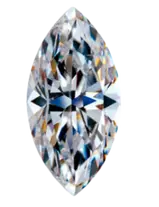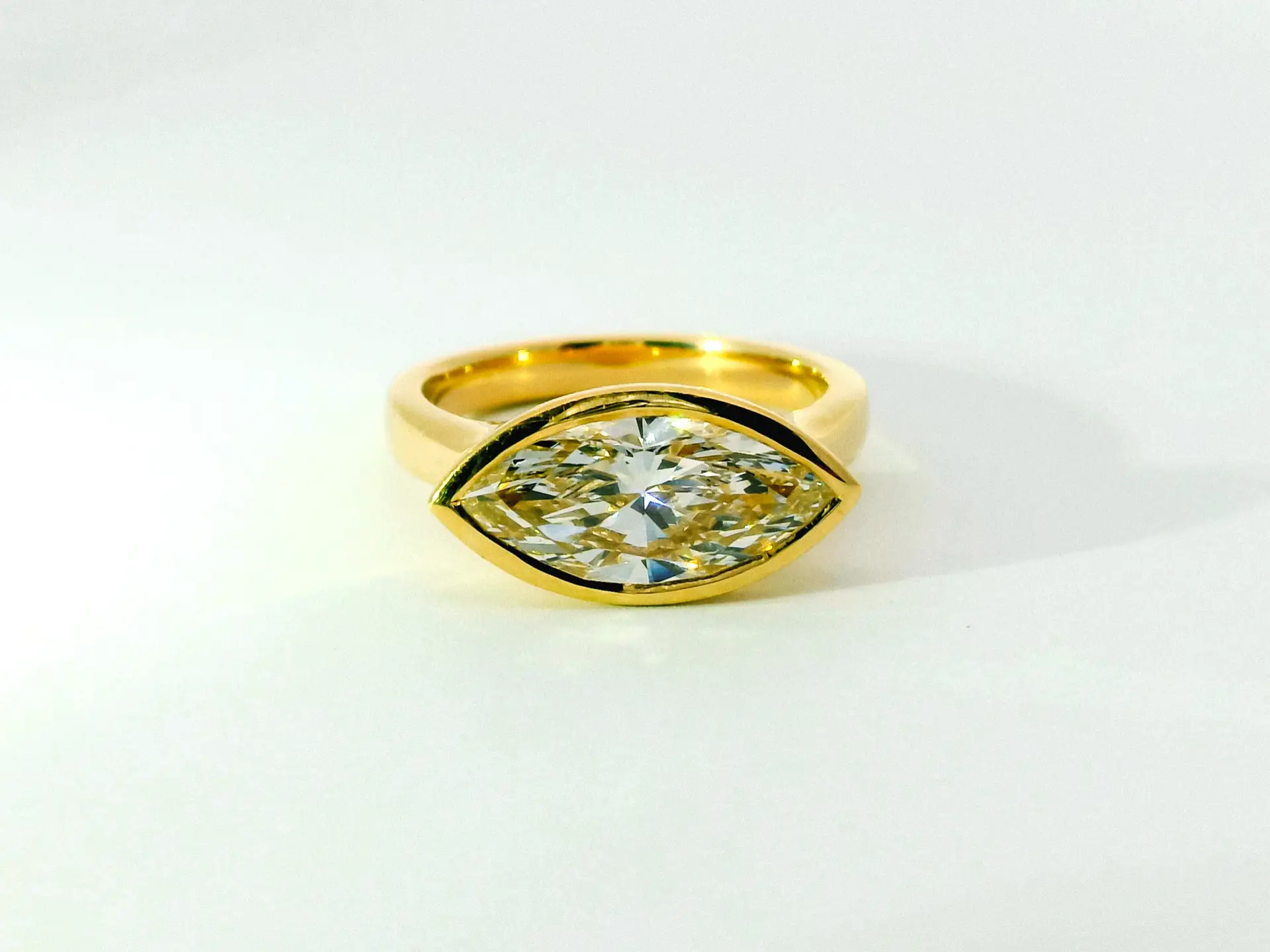 #
#
Gabrielle’s Ideals for Marquise Diamonds #
(Table: 57–63% (59–62%), Depth: 58–63% (59–62%), Pavilion Depth: 41–44% (43%), Pavilion Angle: 40–41° (40.2°–41.25°), Crown Angle: 32–38° (33.7°–35.8°), Crown Height: 12–15%, Girdle: 2.5–4.5%)
The marquise cut diamond is a distinctive and highly elongated brilliant cut, recognized for its dramatic, tapered points and graceful curvature. Known for its rich history and regal associations, the marquise cut provides exceptional finger coverage and a bold, vintage-inspired aesthetic.
The marquise cut dates back to the 18th century, when King Louis XV of France commissioned a diamond shape to resemble the lips of his mistress, the Marquise de Pompadour. The result was an elongated shape with pointed tips, exuding elegance and opulence. Over time, diamond cutters refined the proportions, developing the modern marquise brilliant cut, which maximizes fire, brilliance, and visual size while retaining its historic charm.
Marquise diamonds face up as one of the largest per-carat shapes, often appearing 30–50% larger than round diamonds of the same carat weight. The elongated design creates an illusion of greater size, making it a visually impactful choice for maximizing presence.
#
1. What Is a Marquise Cut Diamond? #
The marquise cut diamond features a brilliant-cut facet structure, optimized for brilliance (white light return), fire (rainbow dispersion), and scintillation (sparkle movement). Its long, curved shape and pointed tips create an eye-catching, elongated look, ideal for those who prefer a bold yet elegant style.
The ideal length-to-width ratio for a marquise cut diamond ranges between 1.85–2.20, with 1.90–2.10 being the sweet spot for balanced proportions.
Why Choose a Marquise Lab Diamond?
- Larger Face-Up Size:
The marquise has one of the largest surface areas per carat, appearing bigger than other diamond shapes of the same weight.
- Distinctive, Elegant Shape:
The tapered, elongated design creates a slimming effect on the fingers, making it an excellent choice for those who want a visually striking engagement ring.
- Brilliant-Cut Facets for Maximum Sparkle:
Like rounds, ovals, and pears, the marquise features a brilliant facet arrangement that delivers high brilliance and fire when cut correctly.
- Versatility in Styling:
It can be set vertically for a classic look or horizontally (east-west) for a modern twist (have you seen our Willow setting?).
Potential Downsides of a Marquise Diamond #
- Bow-Tie Effect:
Like ovals and pears, marquise diamonds can display a dark bow-tie effect across the center if not cut correctly. While a slight bow tie is normal (and expected), an overly dark or distracting one should be avoided. Remember – in a beautifully cut stone, it’s a feature, not a bug – showcasing crispness, depth, and color, in a way that only a diamond can!
- Vulnerability at the Tips:
The marquise’s pointed tips are its weakest structural points, making them prone to chipping if not properly protected by prongs or a bezel setting.
- Proportion Sensitivity:
Achieving optimal brilliance in a marquise relies heavily on getting the table, depth, and pavilion angles right. Even slight deviations can lead to poor light performance or a disproportionate shape.
- Uneven Curves or Flatness:
A well-cut marquise should have smooth, symmetrical curves—not flat areas on the sides or overly sharp points at the tips. Poor symmetry can impact how light reflects and diminish the stone’s beauty.
 #
#
#
2. The 4Cs for a Marquise Lab Diamond #
While all 4Cs matter, cut quality is the most important for marquise diamonds, as it directly affects light return, symmetry, and the overall face-up appearance.
Cut – The Foundation of a Beautiful Marquise Diamond
To achieve the best performance, focus on these key proportions:
- Table Percentage (IGI’s ideals: 57–63% | Gabrielle’s Ideals: 59–62%):
The table is the largest facet where light enters the diamond. A balanced table ensures even dispersion of light, maximizing fire and brilliance.
- Depth Percentage (IGI’s ideals: 58–63% | Gabrielle’s Ideals: 59–62%):
Depth impacts light reflection and face-up size. A well-balanced depth ensures that light reflects efficiently while maintaining a large appearance.
- Pavilion Depth (IGI’s ideals: 41–44% | Gabrielle’s Ideals: 43%):
The pavilion depth determines how well light is redirected back to the viewer’s eye rather than leaking out of the stone.
- Pavilion Angle (IGI’s ideals: 40–41° | Gabrielle’s Ideals: 40.2°–41.25°):
This angle controls how light bounces within the diamond and influences brilliance and fire.
- Crown Angle (IGI’s ideals: 32–38° | Gabrielle’s Ideals: 33.7°–35.8°):
The crown height and angle determine the amount of fire (rainbow dispersion) seen in the diamond.
- Crown Height (12–15%) & Girdle (2.5–4.5%):
A balanced crown height ensures the diamond disperses light evenly, while a properly proportioned girdle provides durability without unnecessary weight retention.
Pro Tip: The table and pavilion work together to control brilliance, while the depth and crown dictate fire and light dispersion. A well-cut marquise doesn’t just check the boxes—it achieves balance between all proportions.
Color – Enhancing the Brightness
Because of their elongated shape, marquise diamonds show color more than round brilliants. The pointed ends can trap color, making a lower-grade stone appear warmer than its actual rating.
- D–F (Colorless): Best for a crisp, icy-white look. Recommended for platinum or white gold settings.
- G–H (Near Colorless): A great balance between value and whiteness, appearing bright in most lighting conditions.
- I–J: Some warmth may be visible, especially at the tips, but can work well in yellow or rose gold settings.
Pro Tip: If you want a bright, white marquise diamond, consider staying within the D–H range, especially if you’re setting it in platinum or white gold.
Clarity – Choosing Eye-Clean Stones
The brilliant-cut faceting of a marquise helps hide inclusions, but the elongated shape means clarity should still be carefully considered.
- VS1–VS2: The best value range, where inclusions are typically invisible to the naked eye.
- SI1–SI2: Some SI1 stones will be eye-clean, but inclusions near the tips should be avoided, as they can weaken the structure.
- VVS1–VVS2: Nearly flawless, but not necessary unless you want absolute perfection.
- F–IF: Flawless diamonds exist but are rarely worth the premium for most buyers.
Pro Tip: VS1–VS2 is the sweet spot for clarity. If considering SI1, check for inclusions away from the tips, as these areas are most vulnerable.
Carat – Maximizing Size Without Compromising Cut
Due to their elongated form, marquise diamonds appear larger per carat than most other shapes. This makes them an excellent choice for those looking to maximize size while staying within budget.
Pro Tip: A well-cut 1.50ct marquise can look larger than a poorly cut 1.75ct stone. Always prioritize cut quality over carat weight.
#
3. Additional Considerations #
Symmetry & Polish
- Symmetry: Excellent symmetry ensures the diamond reflects light evenly for an elegant, well-proportioned appearance. Look for even curves with no flat spots.
- Polish: Excellent or very good polish is the best choice to maximize the crispness and cleanliness of the facets.
Fluorescence
- None or Faint fluorescence is ideal, as strong fluorescence can sometimes cause a hazy appearance.
Certification
- Only buy IGI- or GIA-certified diamonds. Avoid uncertified stones, as cut quality and grading may be unreliable.
Setting Considerations
- Protect the tips! Prongs or a bezel setting should shield the pointed ends from chipping.
- Metal Choice: Platinum or white gold enhances whiteness; yellow/rose gold complements warmer tones.
Final Thoughts #
A well-cut marquise diamond is dramatic, elegant, and full of life. Its unique shape maximizes face-up size while maintaining brilliant light performance. By keeping Gabrielle’s ideals in mind, you can confidently choose a balanced, high-performing marquise diamond that exceeds expectations.
Happy diamond hunting—may your marquise diamond be as bold and brilliant as you are!


